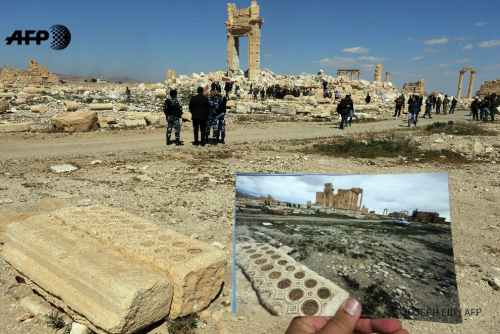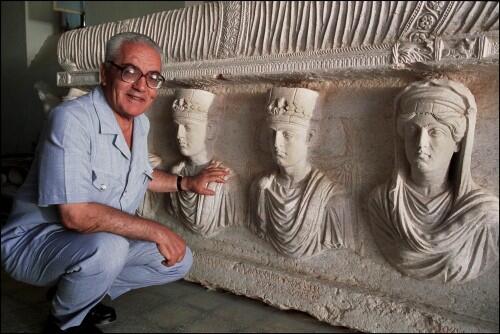The renowned temple of Bel in Palmyra, which was blown up by Islamic State last year, is not beyond repair but the full extent of damage in the ancient city could take weeks to establish because of mines laid amid the ruins, Syria’s antiquities chief said. Satellite pictures taken after the 2,000-year-old temple was dynamited by the jihadi group, and other images broadcast since Syrian government forces retook the city on Sunday, show almost the entire structure collapsed in a heap of rubble.
Bel temple was one of several important monuments blown up in the city last year including the temple of Baal Shamin, a victory arch and funerary towers. The city museum, home to treasured artifacts, was ransacked and statues were smashed or defaced.
Despite the extensive damage, Maamoun Abdelkarim said that the Temple of Bel had not been pulverized and its foundations were largely intact. He added: “What was said about it all being turned to dust – it’s not dust,” Abdelkarim told “Reuters” in Damascus. “There is still a lot of the structure … that can be reused and renovated.” He was speaking before a trip to Paris where he said he would attend a meeting of the United Nations cultural agency UNESCO and seek global help to restore Palmyra.
Consecrated to a Mesopotamian god, the Temple of Bel later served as a Christian church and a mosque. In an inner sanctuary, carvings showed seven planets surrounded by the signs of the zodiac, and a procession of camels and veiled women.
Syrian military engineers were already combing the area for mines which Islamic State are suspected of leaving behind amid the ruins, he said.
Russian de-mining units, using robots and sniffer dogs, have also arrived in Syria to start clearing the area, in the latest support from Moscow to Assad, its Middle Eastern ally.
TREASURE AND GOLD
Islamic State has also razed Assyrian and Roman-era cities in neighboring Iraq – driven by a radical ideology which deems the region’s pre-Islamic heritage as idolatrous and by the lure of profit from selling stolen artifacts.
Other monuments in the oasis city, described by UNESCO as a crossroads of cultures since the dawn of humanity and a major source of interest for archaeologists, historians of the ancient world and tourists, remain including its Roman amphitheatre and long colonnaded avenue.
Officials have inspected damage at Palmyra’s museum, where a 15-tonne statue of a lion holding a crouching gazelle, known as the Lion of Al-Lat, was found broken in the grounds of the building, Abdelkarim said. The statue has already been restored once after it was broken up in antiquity to build another temple.
Abdelkarim said 400 artifacts had been moved from the site for safekeeping before Islamic State overran Palmyra last May, but television images from the museum have shown statues defaced or broken and display cases smashed up.
“Daesh were looking for treasure and gold – they thought there would be tonnes of gold. There was none, because the main articles had been moved to Damascus,” he said.
Describing the headless or defaced carvings, Abdelkarim compared the restoration work they would undergo to the surgery performed on patients with serious burn injuries. “You undergo many surgeries and your face won’t come back as it was, but you’re still alive,” he said.
RUSSIAN DE-MINER ROBOTS
The de-miners will deal with more than 180 hectares of territory, Russia’s defense ministry said, citing initial estimates. The aim is to clear the historic part of the ancient city as well as residential areas.
Their work is complicated by the fact that the retreating Islamic State fighters “left a large quantity of various homemade explosive devices behind them in Palmyra as well as standard mines”, the ministry said. Abdelkarim said the militants had “a plan to destroy the city” but did not go through with it.
In Palmyra, Islamic State carried out excavations, hunting for buried artifacts, but Abdelkarim said it was too early to say how much digging or damage they had done. “We cannot evaluate the destruction to the ruins from the criminal secret excavations … It will take weeks to assess,” he said, given that big parts of the old city are inaccessible.
“We have been into the museum and to the Temple of Bel, the amphitheatre, and the colonnaded street,” Abdelkarim said, adding: “But where there is sandy ground we cannot go … because there could be mines.”
The overall task of clearing Palmyra, which military sources have told Russian media will involve at least 100 servicemen, is expected to take several months.
Russian forces will draw on their extensive experience of de-mining in the volatile North Caucasus region where a low-level Islamist insurgency has been simmering for years.
For the toughest tasks, the Russians said they would use sniffer dogs and Uran-6 de-mining robots, which can be remotely controlled from around 1 km (half a mile) and do the work of 20 de-mining experts.
Russian sappers with robots to clear mines
Russian combat engineers arrived Thursday in Syria on a mission to clear mines in the ancient town of Palmyra, which has been recaptured from Islamic State militants in an offensive that has proven Russia’s military might in Syria despite a drawdown of its warplanes.
The Defense Ministry said the sapper units were airlifted to Syria with equipment including state-of-the art robotic devices to defuse mines at the 2,000-year-old archaeological site. Russian television stations showed Il-76 transport planes with the engineers landing before dawn at the Russian air base in Syria.
Russian Defense Minister Sergei Shoigu on Thursday urged other nations to join the effort of clearing Palmyra from mines.
Sergei Rudskoi, the head of the Main Operative Department of the Russian General Staff, on the other hand, emphasized that the seizure of Palmyra had strategic importance due to its location at the junction of major highways. He added that “the restoration of the Syrian army’s control over Palmyra will make it significantly more difficult for the bandit groups to regroup and move their resources between Syria’s northern and southern regions”.
He also said that “it will also significantly weaken their capability around Damascus and Aleppo,” adding that losing areas rich in natural resources will hurt rebels’ ability to buy weapons and ammunition and pay their forces.
Khaled Al- Assad… Stood tall like Palmyra Ruins
Khaled Al- Assad, who was head of Palmyra Museum, stood tall like Palmyra Ruins, even when he was confronted by ISIS. He did not bow, and insisted that he stands tall like Palmyra ruins. He was one of the most important pioneers in Syrian archaeology in the 20th century and a man who devoted his life to promoting and protecting his home town of Palmyra.
Asaad was involved in early excavations of Palmyra and the restoration of parts of the ancient city. The 82-year-old played a role in evacuating the contents of the city museum ahead of Isis taking control, which, Azm said, meant he faced certain arrest when the militants arrived.
The archaeologist and scholar, who held a diploma in history and education from the University of Damascus, published many books and scientific texts. Among his titles are The Palmyra Sculptures and Zenobia, the Queen of Palmyra and the Orient.
He worked for 40 years as the head of antiquities in Palmyra, which was an important trading hub along the Silk Road 150 miles north-east of Damascus. When he retired in 2003, it was to take up the post of expert with the antiquities and museums department.
Syria’s directorate general of antiquities and museums (DGAM) described him as an “inspirational and dedicated professional who was committed to DGAM even after he retired”.
In 2003, Asaad was part of a joint Syrian-Polish archaeological team to unearth an intact third century mosaic depicting a battle between a human being and a mythical winged animal, and surrounded by geometric drawings of grapes, figs, deer and horses.
At the time, he described the 70 sq m mosaic as “one of the most precious discoveries ever made in Palmyra”.
In 2001 he announced the discovery of 700 silver coins, dating back to the seventh century in the town. The coins, stuck together in one lump, bore the pictures of Kings Khosru I and Khosru II, members of the Sassanid dynasty that reigned in Persia before the Arab conquest. Both kings invaded Syria, the Guadian reported.














